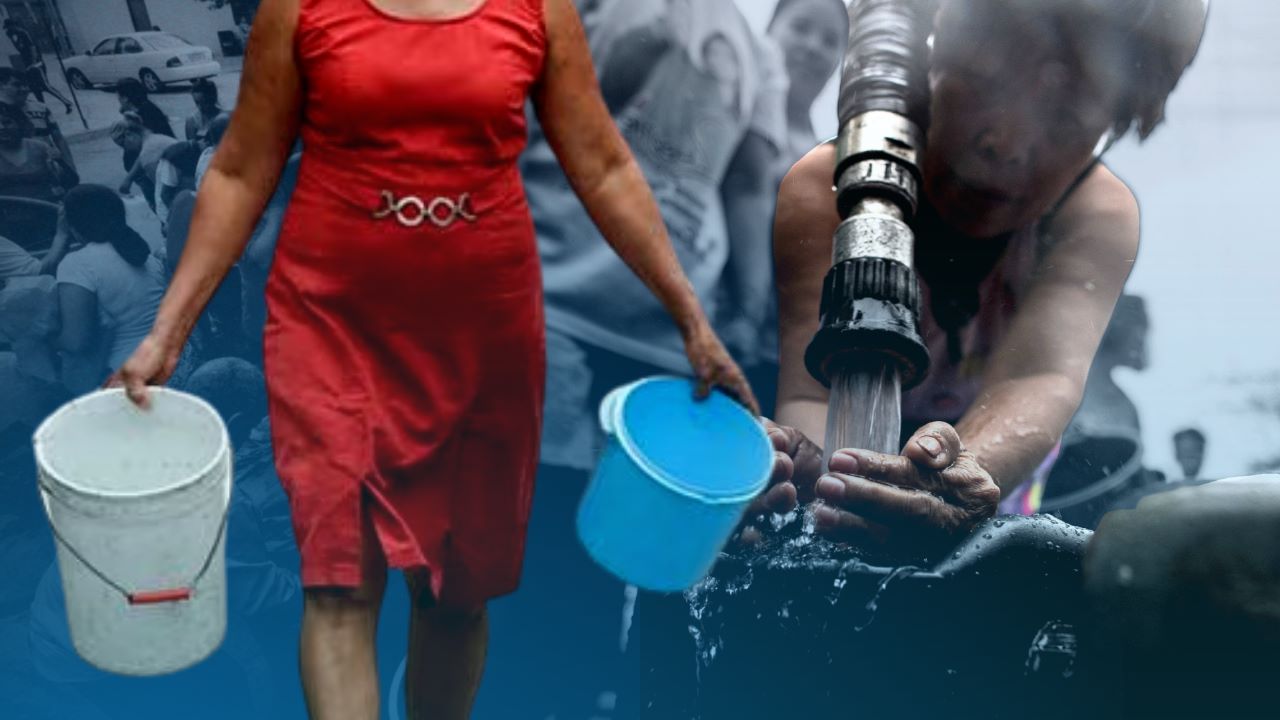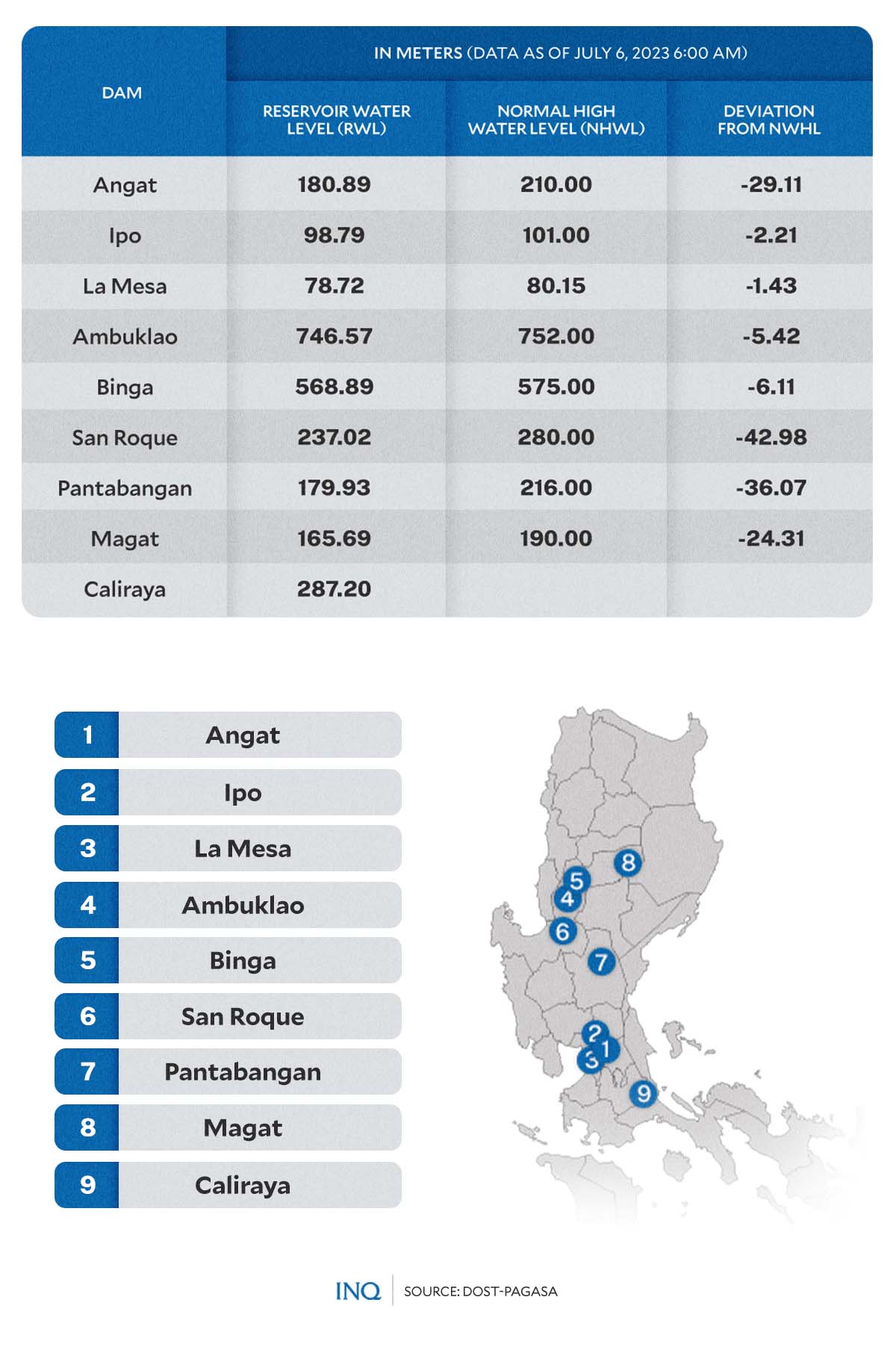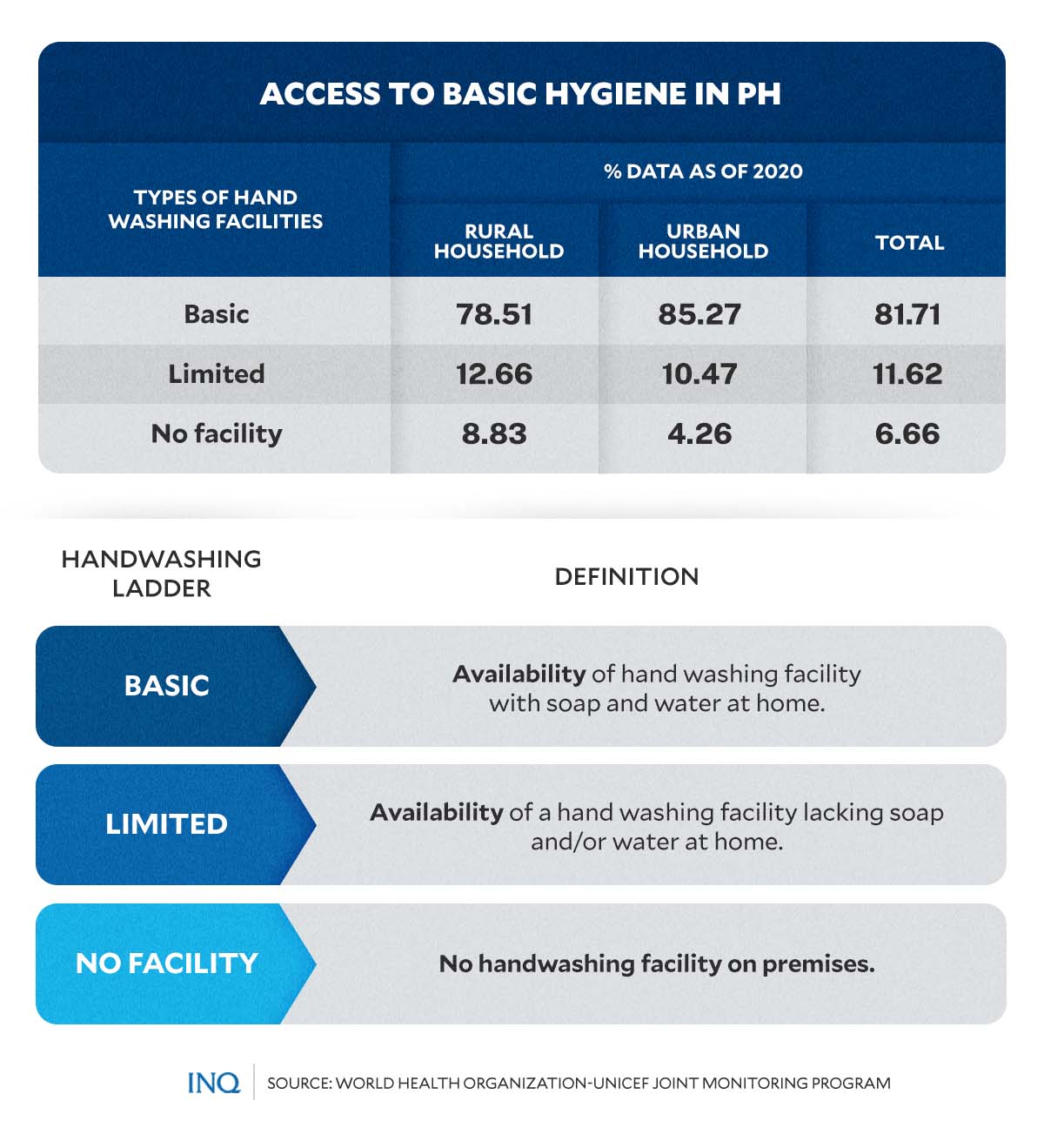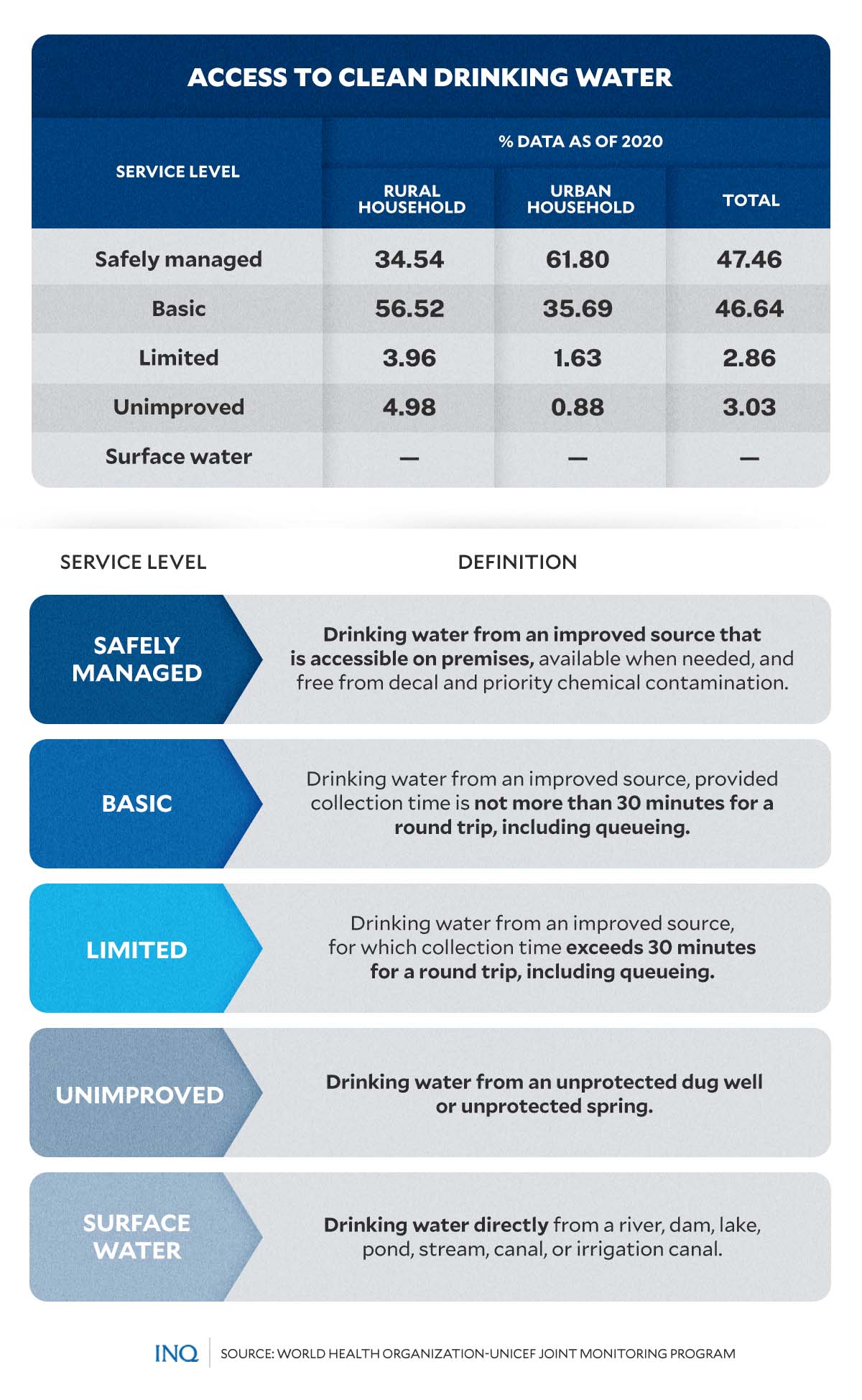El Niño in PH: On top of killer heat, water scarcity looms
MANILA, Philippines—Following the declaration of the onset of El Niño, United Nations and state meteorologists warned against one of its effects which millions of people in the Philippines are already familiar with—water shortage.
On July 4, the UN World Meteorological Organization (WMO) officially declared that El Niño conditions have emerged in the Tropical Pacific for the first time in seven years, with a 90 percent probability of it persisting until the second half of 2024.
“The onset of El Niño will greatly increase the likelihood of breaking temperature records and triggering more extreme heat in many parts of the world and in the ocean,” said WMO Secretary-General Prof. Petteri Taalas in a statement.
WMO defined El Niño as a naturally occurring climate pattern associated with warming ocean surface temperatures in the central and eastern Pacific Ocean.
READ: For the third time this week, Earth sets a heat record on July 6
The phenomenon usually occurs, on average, every two to seven years, and its episodes typically last nine to 12 months. The last El Niño was in 2015-2016.
Article continues after this advertisement“The declaration of an El Niño by WMO is the signal to governments around the world to mobilize preparations to limit the impacts on our health, our ecosystems, and our economies,” said Taalas.
Article continues after this advertisement“Early warnings and anticipatory action of extreme weather events associated with this major climate phenomenon are vital to save lives and livelihoods,” he added.
WMO said this El Niño will be at least of moderate strength. It was also noted that its warming effect on global temperatures is usually felt most strongly within a year of its onset—or, in this case, in 2024.
READ: UN warns world to prepare for El Niño impact
El Niño in PH
The Philippine Atmospheric, Geophysical and Astronomical Services Administration (Pagasa) has also declared the onset of El Niño on July 4, stating that climatologists have observed the weather phenomenon ongoing in the tropical Pacific in the last three months.
“[I]ts effects are starting to be felt in the country,” Pagasa weather specialist Lorie dela Cruz told INQUIRER.net.
READ: Pagasa declares onset of El Niño
Following this announcement, the state weather bureau has upgraded its El Niño-Southern Oscillation (Enso) Alert and Warning System into an El Niño Advisory.
Ana Liza Solis, of Pagasa’s climate monitoring and prediction unit, earlier said that El Niño will likely become powerful in the following months and will persist until the first quarter of 2024.
She added, however, that the Philippines has yet to experience the full effects of El Niño.
“We are still experiencing a weak El Niño, but there are models, and there is a high probability of more than 56 percent that El Niño becomes moderate and strong at least in the last quarter of this year,” she said.
READ: PH among nations most at risk to El Niño
Public warned of El Niño’s impact
As early as last March, when the dry season has officially begun, Pagasa and other government agencies have warned the public to take precautionary measures against the effects of El Niño.
That same month, the state weather bureau upgraded its monitoring of oceanic temperatures to an El Niño Watch, signaling the high likelihood of the El Niño phenomenon being felt in the coming months.
“The public and all concerned government agencies are advised to take precautionary measures to minimize heat stress, optimize the daily use of water for personal and domestic consumption, and prevent any accompanying health risks associated with this climate condition,” Pagasa said, stressing the likelihood of persistent dry and hot days nationwide.
The Department of Health (DOH) also warned against the high possibility of several illnesses rapidly spreading in communities amid intense heat.
Aside from heat stress and heat stroke, these illnesses include gastrointestinal problems like cholera, and typhoid fever, and food and waterborne diseases like bloody diarrhea and hepatitis.
READ: Extreme heat in PH: Health risks, economic impact
READ: Preparing for El Niño: The heat is on and our health is at risk
“If you are not sure whether your source of [drinking] water is safe, boil the water first before drinking it, just to be sure,” said Health Undersecretary Maria Rosario Vergeire at a press briefing held when she was still Department of Health officer-in-charge.
The health department also stressed on one of the most dangerous effects of a combination of dry season and El Niño—a water crisis. This, according to Vergeire, could lead to an insufficiency of water sources and epidemic of various diseases related to water shortage or contamination.
READ: Beware of disease outbreaks amid intense heat, water shortage – DOH
Vergeire said El Niño can be attributed to climate change.
“Climate change is a very critical [issue] … If our environment will be affected by changes in our climate, definitely there will be an [outbreak] of illnesses,” she said.
Conserve water, prevent shortage
To prevent supply shortage, Malacañang directed all national government agencies to strictly implement water conservation measures.
In Memorandum Circular (MC) 22 released last month, Malacañang mandated all national government agencies, including government-owned corporations and state universities and colleges, to identify and implement conservation measures that will result in a 10 percent reduction in water consumption.
“With the probability of the El Niño phenomenon occurring within the next few months, there is an urgent need to implement water conservation measures to avert a looming water crisis not just in Metro Manila but in all other areas in the country experiencing water scarcity,” said the MC, signed by Executive Secretary Lucas Bersamin.
Last May, Interior Secretary Benjamin Abalos Jr. also instructed local government units (LGUs) to find ways to cushion the impact of El Niño from June this year until March of next year.
“Conserving water is one of the key actions needed to be taken to mitigate the effects of El Niño, and as public servants, we must set an example. These precautionary steps, albeit small, can make a big difference that can affect our communities,” Abalos said in a statement.
READ: DILG to LGUs: Save water, prepare for El Niño’s fury
READ: Preparing for El Niño
An official of the National Disaster Risk Reduction and Management Council (NDRRMC) earlier estimated that El Niño will affect at least 11 provinces by August. By October, the number of affected provinces will increase to 46.
In some areas of the country, preventive measures against water scarcity were already in place as early as last March.
An example would be Cebu City, which started to ration water as some barangays experienced supply scarcity ahead of the onset of El Niño.
READ: Ahead of El Niño: Water rationing starts in some Cebu City brgys
Amid consistent warnings and reminders to conserve water, an expert recommended shifting to a plant-based diet, which he said will help save water and address food security issues.
Dr. Teodoro Mendoza, a University of the Philippines-Los Baños retired crop science professor, explained that a meat-based diet is “resource inefficient,” saying that “a lot of resources are consumed in producing livestock […] they also consume a lot of water and nutrients.”
READ: Give up meat? It could help ease El Niño impact, water use, says expert
What went before
In the past, El Niño brought severe drought and water supply shortages across the Philippines.
In a statement dated August 1998, ACT Alliance—a Switzerland-based non-governmental organization composed of over 140 member organizations across the globe—said that El Niño had caused a severe shortage of rains and droughts in many different regions in the Philippines in October 1997, which lasted for months.
“Almost every part of the country has been affected. Crop yields are low and, in places, non-existent. The severity of the drought that has sorely affected those persons who rely on rainfall for their livelihood,” ACT Alliance said.
“There have been reports of deaths amongst the most vulnerable, and particularly those who live in the most remote areas, and who rarely receive any aid which may be available during times of crisis,” it added.
Research published by the Columbia Climate School International Research Institute for Climate and Society further detailed the impact of the strong El Niño in the country in 1997.
It said at that time, 70 percent of the Philippines suffered from severe drought. Water levels in the Angat Dam reservoir, the main source of potable water in Metro Manila and other areas, “became critically low averaging 32% of normal levels.”
The severe drought and water scarcity led to a 6.6 percent drop in agricultural and fisheries production in the country.
Another instance was in 2015-2016 when a strong El Niño brought drought in the country. It lasted 18 months and caused damage across 16 of 18 regions—around 85 percent of the country—making it the most severe El Niño event ever recorded, according to World Food Programme.
Most recently, in 2019, El Niño again caused droughts nationwide. This has been exacerbated by lack of water as water levels in major dams—Angat and La Mesa—dropped to critical levels.
In April of that year, then-President Rodrigo Duterte slammed the Metropolitan Waterworks and Sewerage System (MWSS)—the government agency in charge of water privatization in Metro Manila—for being unprepared for the El Niño season.
By August, Duterte reactivated the government’s El Niño Task Force to mitigate the effects of the dry spell in the Philippines.
READ: Duterte reactivates El Niño Task Force
Government, water companies lay out plans
Last week, Pagasa said Camarines Norte and Southern Leyte would likely experience drought in the coming months due to the effects of the El Niño phenomenon.
At least 28 provinces and areas nationwide might experience “dry conditions” or two consecutive months of below-average rainfall conditions. “Dry spell,” or three consecutive months below regular rainfall occurrences, is also expected in 36 provinces in Luzon and Visayas.
READ: Pagasa: El Niño may bring drought to Camarines Norte, Southern Leyte
The Local Water Utilities Administration, the National Water Resources Board, and the Metropolitan Waterworks and Sewerage System were already asked by the Palace to submit a “monthly supply-demand projection,” highlighting the likelihood of a deficit in the water supply.
Government-run and private water service providers (WSPs) were also directed to implement water conservation measures.
READ: El Niño threat: Malacañang urges gov’t agencies to save water now, avoid crisis later
Last April, President Ferdinand “Bongbong” Marcos ordered the creation of a government team that would focus on mitigating the impact of the El Niño phenomenon.
READ: President orders creation of team to mitigate El Niño impact
In the same month, two water concessionaires for Metro Manila and adjacent areas assured that they have lined up various measures to brace for the impact of El Niño on the water supply.
READ: Water firms ready supply projects ahead of El Niño
Recently, the water level at Angat Dam was seen slowly dropping to its minimum operating level despite rains over the past few days.
Last July 5, National Water Resources Board (NWRB) executive director Dr. Sevillo David Jr. said the water level at the dam in Norzagaray, Bulacan, was 181.22 meters.
He added that the water level at the dam has been inching closer to the 180-meter minimum operating level because the recent rainfall did not reach the watershed.
“Once the water level is lower than 180 meters, the priority will be to ensure there is enough water supply in Metro Manila, rather than for other uses like irrigation and power generation,” David said at a briefing last Wednesday.
The last time the Angat water level breached the critical level of 160 meters was in June 2019.
READ: Angat water level continues to drop at onset of El Niño
As of July 6, records from Pasasa showed that the water level in various dams in the country was as follows:
- Angat: 180.89 meters
- Ipo: 98.79 meters
- La Mesa: 78.72 meters
- Ambuklao: 746.57 meters
- Binga: 568.89 meters
- San Roque: 237.02 meters
- Pantabangan: 179.93 meters
- Magat: 165.69 meters
- Caliraya: 287.20 meters
Access to water sources still an issue
Aside from looming water supply problems, it should also be noted that the country also currently experiences issues with access to adequate water sources.
A survey by the Social Weather Stations (SWS) released last April showed that in the Philippines, only 67 percent of families have access to running and piped water. This equates to at least 17 million Filipino households.
READ: Only 67% of Filipino families have access to running, piped water – SWS
According to NWRB, at least 11 million families in the country still have no access to clean water.
These families, David explained, rely on “unprotected” water sources such as deep wells, springs, rivers, lakes, and even rainwater.
READ: 11 million Filipino families have no access to clean water — NWRB
According to a study by the World Health Organization (WHO) and the Unicef Joint Monitoring Program (JMP), in 2020, almost half, or 47.46 percent of the country, had access to safely managed drinking water.
READ: WHO-Unicef report: Nearly half of Filipinos get safe drinking water
This refers to drinking water from uncontaminated sources accessible on premises, available when needed, and free from fecal and chemical contamination.
Most rural households relied on basic water services or drinking water from so-called improved sources. Water from these sources takes less than 30 minutes to collect.
But over 2 million households got their drinking water from unimproved water sources such as unprotected wells or springs during the same period.
When it comes to hygiene, while most households are already accessing soap and water, at least 7 million households still suffer from a lack of hand washing facilities and have no access to soap and water.




